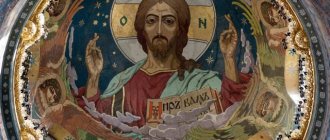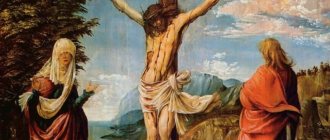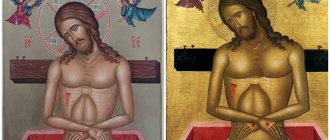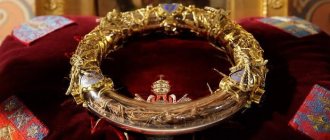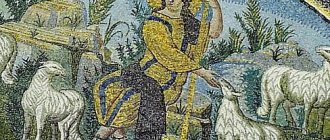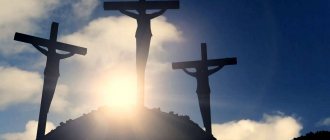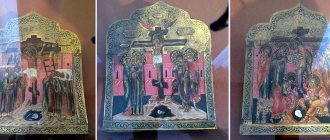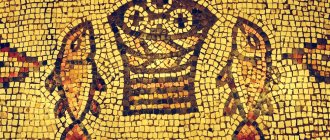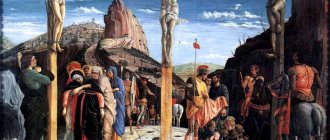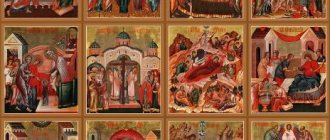0
(0)
Rice. 1. The “King of Glory” icon represents the Lord to us as the great Heavenly King in all His Glory and a just Judge, the way He will judge people on the day of God’s Last Judgment.
The icon of Jesus Christ “King of Glory” is the famous image of Christ, in which He is depicted as the King sitting on the throne, with all the royal attributes, as we will see him on the last day, when He comes to judge all people in all his glory. The image patronizes all those in authority and power.
In this article we will talk about the history of this image, its meaning, and we will also figure out where it is better to hang such an icon at home, how to pray correctly in front of the image, what helps and what such a prayer protects from.
History of the icon of Christ
The first image of Jesus Christ was given by himself. When a messenger from the king of Edessa, who was suffering from leprosy, sent an artist to paint the face of Christ, from which, as he sincerely believed, he could be healed. But the artist could not approach Christ in any way to make an accurate portrait, and then Jesus Christ washed his face in water and, taking the cloth (obrus), wiped himself with it, and after that an image of the face of Christ appeared on the obrus.
This was the first image of the Savior in which only His face is visible; later, icons of this type received the name of the Savior Not Made by Hands. Based on this image, icon painters developed several more versions of the icon of the Savior.
Icon of Jesus Christ King of Kings (King of Glory)
- Emmanuel, when Jesus is depicted as a child of a youth, and the image is half-length, and a characteristic sign that it is the Savior is a halo with a cross, which belongs only to icons of Jesus Christ.
- Almighty. This is, as a rule, Christ in his half-length depiction of the Lord, seated on a throne and holding the Holy Scriptures in his right hand, and blessing people with his left hand
- Deesis, this word can be translated as prayer, here the King of Kings sits on a throne, and on both sides of him the Most Holy Theotokos and St. John the Baptist, who bowed before him in a prayer position. Sometimes the apostles and some saints are also depicted as those present.
On a note!
There are several more images of Christ on icons such as “The Great Bishop of the Savior”, “Christ the Good Silence”, “The Good Shepherd” and “Christ in the Tomb”. These icons are always displayed in the form of the Shroud on Holy Saturday, when believers can venerate throughout the day, until the beginning of Easter Vespers. There are clear rules for all images of Christ:
- a cross with a letter designation within the Greek alphabet, which is translated as Jesus Christ, is always inscribed in the halo;
- the face itself is elongated, is always depicted facing the viewer and has subtle facial features;
- The Savior always wears simple clothes and his face is turned to the one who looks at him.
But in addition to these images of the incarnate Lord, there is also the icon of Jesus Christ the King of Glory, which is important among believers and especially those who occupy some kind of high leadership position.
More about icons of Christ:
- How do icons of Christ help?
- Icon “The All-Seeing Eye of God”
- Icon of the Exaltation of the Cross of the Lord
Description of the Holy Face
The icon differs from all its previous images, first of all, in this:
- The Savior is shown in all his majesty, seated on a throne;
- he is dressed in royal clothes, which are called dalmatic, that is, a shirt with sleeves up to the wrist and lor, a long ribbon with which the clothes of kings and high dignitaries were tied.
Icon "Lord King of Glory"
Both the dalmatic and the long ribbon are all clothes of both commoners and nobles. It’s just that commoners didn’t tie up Dalmatics. In the icon of Jesus Christ the King of Glory, they are transformed in their appearance, united in their meaning and acquiring a special right, as the unifying affiliation of all people through Jesus Christ.
Important! In this case, the image of the King of Kings is interpreted both as a real ruler, a judge of the people and as a bishop who decides all the affairs of his people. Separates the righteous from the sinner and determines the fate of each of them.
In fact, this icon defines what Jesus Christ was formally executed for, what was depicted on the tablet nailed to the cross by order of Pontius Pilate. Namely, that he is the “King of the Jews.” This could be perceived as a political claim to dominance over a certain territory, but in fact it was the proclamation of the King of Kings in general over all the rulers of the world by right of his heavenly reign, determined by the Lord.
Gospel narrative
How the death penalty of God the Son took place is described in all four Gospels of Matthew, Mark, Luke and John. In general terms, the episode in question in the life of Jesus described by each evangelist has much in common with the others. The apostles recorded in their own Gospels what they saw themselves. Trying not to be deceived in the writing process, everyone tried to accurately convey the event line of the crucifixion of Christ.
Some emphasized partial description of the moment. For example, Matthew provides the reader with information according to which Jesus was brought to Calvary and offered to drink vinegar.
He agreed and no longer demanded water for himself. Meanwhile, the guards began to divide the clothes by lot. A tablet is mentioned, which is considered to be a confirmation of Christ's Destiny. According to Matthew, it was inscribed with “Jesus, King of the Jews.”
Two thieves are mentioned that were crucified on opposite sides of the Savior. The fragment itself is quite scanty and more amazing facts from the event in question can be found in other evangelists.
Mark reports slightly different data. According to him, after Jesus was brought to Calvary, He was offered to drink not vinegar, but wine with myrrh. In the past, this drink was considered a weak pain reliever. It was offered to every convict. But Christ refused him.
Crucified, he hung next to other criminals. Thus the prophecy came true, which said that the Savior would be counted among the villains. People passing by slandered him. They asked why the one who saves others cannot save Himself? To which God the Son remained silent and steadfastly endured his torment. There is a little more information in this description, but even here it is not enough for a complete picture of the event to form in my head.
We advise you to study A child is drawn to bad company: what to do and what prayers to read?
You can learn more facts from Luke
They omit the moment of taking vinegar or wine, but concentrate their attention on little things that have more allegorical meaning than in the description of events. The evangelist’s narrative begins directly with the crucified state of Christ
On the right and left sides of him hang robbers who were condemned according to their deserts. Above the Savior’s head hangs a sign with the inscription “Behold the King of the Jews.” It is noteworthy that the author indicates that it was written in Hebrew, Greek and Roman. But the conversation with the robbers gets more insight. One, being in a hopeless situation, blasphemed the Lord and mocked Christ, the other condemned him and sincerely repented of his own sins. The Son of God saw this and allowed him to enter the Heavenly Kingdom after his death.
John the Theologian gives the most detailed information, since he was at Calvary at that moment and was honored to describe everything that he saw before and during the execution. The plot of drawing up a tablet for Christ is described in detail.
According to the evangelist, it was written by Pontius Pilate in Greek, Roman and Jewish languages. The following was inscribed: “Jesus of Nazareth, King of the Jews.” This outraged the high priests. They demanded that the inscription be changed, but the procurator refused to do so. After Jesus was crucified, the soldiers began to divide
His clothes, which were removed from Him in advance before being placed on the cross. The problem was the tunic, which was not sewn, but one-piece. They decided to divide it by lot. At the moment of the Savior’s suffering, three women were found near Christ, His Mother, her sister and Mary Magdalene.
As follows from the Gospels, each author gives his own vision of events and pays attention to those that are important within the framework of Christian teaching. When analyzing each fragment, together with the others, there is a chance to get a complete picture of how the Son of God actually died on the cross of Calvary
Variations
The thought of the Kingdom in the minds of the Orthodox was very strong, and therefore variations of this icon arose on the theme of the dominion of faith already in the current century or the nearest, subsequent centuries after the crucifixion of the Resurrection and Ascension of Christ, i.e. the emergence of the kingdom of saints already now.
Therefore, some variants of the image of the icon of the King of Glory have appeared.
- In the very first image, dating back to the 7th century. and the authorship is unknown, Jesus Christ is on the throne in full royal vestments and in full height, in his right hand he has the unfolded Holy Scripture, and in his left is a scepter, a prototype of the rod with which the shepherd controls his obedient sheep.
- Another image dates back to the 11th century. and the authorship of the King of Kings is attributed to St. Alypiy Pechersky. In this version, new elements of the icon of the King of Glory already appear: here the Lord is on the throne, in full growth and in royal robes, but he is confronted on the right side by St. John the Baptist, and on the left is the Most Holy Theotokos. Another name for this type of icon is “Present Queen”.
Icon of Jesus Christ “King of Glory”
In fact, there are four options: where Christ sits on the throne alone, the image of His face, the Deesis, where he is with two standing, and the baby Emmanuel. But in any case, the image of the King of Glory as an icon stands out among the few options for depicting the Savior, because it reminds the common man that Christ is not only a good shepherd, ready to forgive all our sins, but also a formidable king of the Universe who must be obeyed.
Spas Blagoye Silence
He is also called the Angel of the Great Council. This is an icon of the Savior (photo or any other image of him), showing Christ before his earthly incarnation. He is represented by an angel - a young man with large wings behind his back. Above his head he has a cross or a special octagonal halo. It consists of red and black squares superimposed on each other. The colors represent the divinity and incomprehensibility of the Creator.
In Rus', this angel was depicted from the waist up, with a special eight-pointed halo and folded hands. The icon became most famous and popular in the 18th-19th centuries. The image of Christ symbolized humility and inaction in the face of destined trials and even death.
This icon enjoyed honor and respect among both Old Believers and pilgrims. However, it has not received proper distribution, and it is quite difficult to find ancient examples of it.
What does it help with?
One of the four images of the Savior should be in the home of any believer, since daily prayers are performed in front of it and this is the visible presence of the Lord in our lives. But what they pray to the icon of the King of Glory in specific cases can be reduced to the following postulates:
- prayers to her help, first of all, those people who occupy positions of authority; this is natural, since the Lord appears in this form precisely as a King, a Master, which means He can help those who are responsible for others;
- Jesus Christ will certainly provide it to those bosses who turn to Him with all sincerity and hope for help, and if the boss is interested in this help, everything will work out in his life, and he will receive what he was counting on;
- But, first of all, an ordinary person must have such an icon in his home and turn to the Savior with any request in full confidence that he will receive help.
Important! These icons are always present in the home of any person who has even a little faith in Christ and his promise, and He always lives up to these expectations.
When commemorated
Any icon has its own days of remembrance, just like saints. But there is a special attitude towards the icon of the King of Kings.
The icon painter was inspired to paint such an icon by the Apocalypse, that is, that book of Holy Scripture that tells about the end of the world. In fact, its plot concerns the Last Judgment, which means the commemoration falls on the Week of the Last Judgment, and this is a conspiracy for Lent.
Orthodox online store Saints - icons of Jesus Christ “King of Kings”.
Days of celebration
The Russian Orthodox Church does not mark a constant date for the celebration and veneration of this icon. Since the shrine “King of Kings” is an image written according to the plots of the Holy Book, its celebration is attributed to the second appearance of the Savior, which will happen on the day when people will appear before the Last Judgment, taking responsibility for all sinful acts, and will receive retribution for them .
The celebration falls on the third preparatory Sunday before Easter, also called the Week of the Last Judgment. This is the last day when Christians can not limit themselves to a variety of food before Lent.

